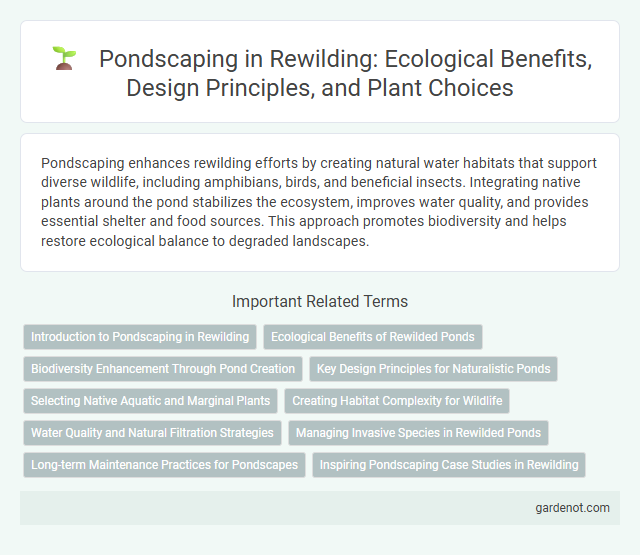Pondscaping enhances rewilding efforts by creating natural water habitats that support diverse wildlife, including amphibians, birds, and beneficial insects. Integrating native plants around the pond stabilizes the ecosystem, improves water quality, and provides essential shelter and food sources. This approach promotes biodiversity and helps restore ecological balance to degraded landscapes.
Introduction to Pondscaping in Rewilding
Pondscaping in rewilding involves creating natural ponds that support biodiversity and restore native aquatic ecosystems. These ponds provide critical habitats for amphibians, insects, and birds while improving water quality through natural filtration processes. Integrating native plants and avoiding chemical use enhances the ecological balance and promotes sustainable wildlife corridors.
Ecological Benefits of Rewilded Ponds
Rewilded ponds enhance biodiversity by providing natural habitats for amphibians, insects, and aquatic plants, promoting ecosystem balance and resilience. These ponds improve water quality through natural filtration processes and support pollinators by creating diverse plant communities along the water's edge. Rewilded ponds also contribute to carbon sequestration and flood mitigation, making them essential components in sustainable landscape restoration.
Biodiversity Enhancement Through Pond Creation
Pondscaping enhances biodiversity by creating aquatic habitats that support diverse species, including amphibians, insects, and aquatic plants. These ponds contribute to ecosystem restoration by increasing habitat complexity and providing vital breeding grounds for wildlife. Integrating native vegetation around ponds further enriches local biodiversity and promotes ecological balance.
Key Design Principles for Naturalistic Ponds
Key design principles for naturalistic ponds in pondscaping emphasize creating diverse aquatic habitats by incorporating native plants, varying water depths, and gently sloping edges to support amphibians and insects. Using natural materials like stones and logs enhances ecological balance and provides shelter for wildlife. Maintaining water quality with minimal chemicals ensures a self-sustaining ecosystem aligned with rewilding goals.
Selecting Native Aquatic and Marginal Plants
Selecting native aquatic and marginal plants for pondscaping enhances biodiversity and supports local wildlife by providing essential habitats and food sources. Species such as water lilies (Nymphaea spp.), cattails (Typha spp.), and pickerelweed (Pontederia cordata) are well-adapted to regional water conditions and contribute to natural filtration and oxygenation. Incorporating a variety of native plants improves ecosystem resilience, reduces maintenance, and promotes a balanced aquatic environment in rewilding projects.
Creating Habitat Complexity for Wildlife
Pondscaping enhances wildlife habitat complexity by incorporating diverse plant species, varied water depths, and natural features like logs and rocks that support amphibians, insects, and birds. Creating shallow margins encourages the growth of emergent vegetation, providing shelter and breeding grounds for aquatic organisms. Structural diversity within the pond ecosystem increases ecosystem resilience, promoting species richness and ecological balance.
Water Quality and Natural Filtration Strategies
Pondscaping enhances water quality by integrating natural filtration strategies such as aquatic plants, biofilters, and microbial communities that remove pollutants and balance nutrient levels. Emergent vegetation like cattails and reeds absorb excess nitrogen and phosphorus, reducing algal blooms and improving oxygen levels. Incorporating gravel beds and porous substrates promotes beneficial bacteria growth, which breaks down organic waste and maintains a healthy aquatic ecosystem.
Managing Invasive Species in Rewilded Ponds
Effective pondscaping in rewilded ponds requires vigilant management of invasive species such as water hyacinth (Eichhornia crassipes) and Eurasian watermilfoil (Myriophyllum spicatum), which can disrupt native aquatic ecosystems. Employing manual removal, biological controls like introducing native herbivorous fish, and maintaining water quality balance are crucial strategies to preserve biodiversity. Regular monitoring and habitat restoration support the reestablishment of native flora and fauna, enhancing ecological resilience in rewilded pond environments.
Long-term Maintenance Practices for Pondscapes
Long-term maintenance practices for pondscapes in rewilding prioritize natural ecosystem balance by promoting native vegetation and minimizing chemical use. Regular monitoring of water quality and biodiversity supports aquatic health and resilience without disruptive interventions. Seasonal management of sediment and invasive species ensures sustainable habitat conditions for wildlife over time.
Inspiring Pondscaping Case Studies in Rewilding
Inspiring pondscaping case studies in rewilding demonstrate how natural water features enhance biodiversity by creating habitats for amphibians, insects, and aquatic plants. Projects integrating native vegetation and organic shapes restore ecological balance while supporting pollinators and improving water quality. These examples highlight the role of pondscaping in reconnecting fragmented ecosystems and fostering resilient, self-sustaining wildlife corridors.
Pondscaping Infographic

 gardenot.com
gardenot.com